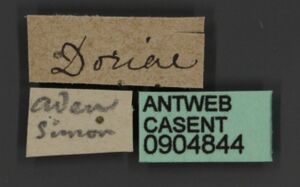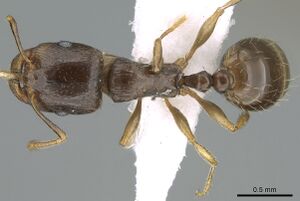Tetramorium doriae
| Tetramorium doriae | |
|---|---|

| |
| Scientific classification | |
| Kingdom: | Animalia |
| Phylum: | Arthropoda |
| Class: | Insecta |
| Order: | Hymenoptera |
| Family: | Formicidae |
| Subfamily: | Myrmicinae |
| Tribe: | Crematogastrini |
| Genus: | Tetramorium |
| Species: | T. doriae |
| Binomial name | |
| Tetramorium doriae Emery, 1881 | |
Nothing is known about the biology of Tetramorium doriae.
Identification
Bolton (1980) - The three species T. doriae, Tetramorium gracile and Tetramorium praetextum form a close complex of species within the setigerum-group characterized by their feebly developed frontal carinae, very reduced propodeal armament and long petiole nodes. The South West African T. praetextum is easily distinguished from the other two as it lacks projecting hairs on the sides of the head behind the eyes, and has the first gastral tergite faintly punctulate or shagreened basally. Beside this the eyes of T. praetextum are relatively smaller than in T. doriae or' T. gracile, being only 0.24-0.25 x HW, as opposed to a range of 0.29-0.33 x HW in the other two species. Tetramorium doriae and T. gracile are a very closely related species-pair which may eventually prove to be just expressions of a single variable species. The former is known from Ethiopia, Eritrea and the Arabian peninsula, the latter only from southern Ethiopia. The two are separated on details of sculpture, as in T. doriae the pronotum has a partial or complete rugoreticulum whilst in T. gracile the promesonotum is predominantly unsculptured, with only faint traces of rugulae.
Keys including this Species
Distribution
Latitudinal Distribution Pattern
Latitudinal Range: 22.816667° to 13.009167°.
| North Temperate |
North Subtropical |
Tropical | South Subtropical |
South Temperate |
- Source: AntMaps
Distribution based on Regional Taxon Lists
Afrotropical Region: Eritrea (type locality), Ethiopia, Saudi Arabia, United Arab Emirates, Yemen.
Palaearctic Region: Oman.
Distribution based on AntMaps
Distribution based on AntWeb specimens
Check data from AntWeb
Countries Occupied
| Number of countries occupied by this species based on AntWiki Regional Taxon Lists. In general, fewer countries occupied indicates a narrower range, while more countries indicates a more widespread species. |

|
Estimated Abundance
| Relative abundance based on number of AntMaps records per species (this species within the purple bar). Fewer records (to the left) indicates a less abundant/encountered species while more records (to the right) indicates more abundant/encountered species. |

|
Biology
Castes
Worker
Images from AntWeb
   
| |
| Syntype of Tetramorium doriae. Worker. Specimen code casent0904844. Photographer Z. Lieberman, uploaded by California Academy of Sciences. | Owned by MSNG, Genoa, Italy. |
   
| |
| Worker. Specimen code casent0906434. Photographer Estella Ortega, uploaded by California Academy of Sciences. | Owned by KSMA; KSU, King Saud University Museum of Arthropods. |
Nomenclature
The following information is derived from Barry Bolton's Online Catalogue of the Ants of the World.
- doriae. Tetramorium doriae Emery, 1881b: 530 (w.) ETHIOPIA. See also: Bolton, 1980: 277.
Unless otherwise noted the text for the remainder of this section is reported from the publication that includes the original description.
Description
Worker
Bolton (1980) - TL 3.2-3.8, HL 0.78-0.90, HW 0.66-0.72, CI 80-84, SL 0.69—-0.80, SI 105-111, PW 0.46-0.53, AL 0.92-1.08 (4 measured).
Mandibles longitudinally striate. Anterior clypeal margin entire, without a median notch or impression. Frontal carinae very weakly developed, no stronger than the remaining cephalic sculpture and rapidly fading out or merging with the sculpture behind the level of the posterior margins of the eyes. From the clypeus to the level of the eyes, where the carinae are fairly distinct, they are close together (maximum separation about 0.39-0.42 x HW), and are roughly parallel. Antennal scrobes absent: SI > 100. Eyes relatively large, their maximum diameter 0.22-0.24, about 0.31—0.33 x HW. Alitrunk in profile long and low, the metanotal groove usually faintly impressed but sometimes obscure. Propodeum unarmed, the dorsum and declivity merely meeting in an angle, or at most with a pair of minute denticles at the junction of the two surfaces. Metapleural lobes broadly and usually bluntly triangular. Node of petiole in profile with the dorsal surface as long as, or slightly longer than, the height of the tergal portion of the node. Antero- and posterodorsal angles usually blunted, the two separated by a shallowly convex dorsum. With the petiole in dorsal view the node slightly longer than broad. Dorsum of head sparsely sculptured, with 4-5 feeble rugulae between the frontal carinae beside the very weak median carina. Occipital region with a very weak, almost effaced reticulum, the meshes of which are poorly formed and inconspicuous. Spaces between sculpture on head shining, ground-sculpture vestigial or absent. Pronotal dorsum irregularly rugulose, at least the anterior portion with a partial or complete rugoreticulum. Scattered fine rugulae present elsewhere on dorsal alitrunk and also present on dorsal surfaces of petiole and postpetiole, where they have a tendency to be predominantly longitudinal. Base of first gastral tergite smooth and shining. All dorsal surfaces of head and body with numerous standing hairs, the appendages only with fine pubescence. On the dorsal (outer) surface of the hind tibiae the pubescence is somewhat raised, subdecumbent to decumbent rather than appressed. Ventral surface of head with very long, anteriorly curved hairs present. Colour yellowish brown to mid-brown.
Type Material
- Syntype, 1 worker, Assab, Eritrea, January, 1880, G. Doria, Naturhistorisches Museum Wien, Vienna; see Madl (2019).
- Syntype, worker(s), Bogos, Assab, Eritrea, January, 1880, G. Doria, Musee d'Histoire Naturelle Genève; see Bolton (1980).
References
- Bolton, B. 1980. The ant tribe Tetramoriini (Hymenoptera: Formicidae). The genus Tetramorium Mayr in the Ethiopian zoogeographical region. Bulletin of the British Museum (Natural History) Entomology. 40(3):193-384.
- Borowiec, L. 2014. Catalogue of ants of Europe, the Mediterranean Basin and adjacent regions (Hymenoptera: Formicidae). Genus (Wroclaw) 25(1-2): 1-340.
- Collingwood, C.A., Agosti, D., Sharaf, M.R., van Harten, A. 2011. Order Hymenoptera, family Formicidae. Arthropod fauna of the UAE 4: 405-474.
- Emery, C. 1881b. Viaggio ad Assab nel Mar Rosso dei Signori G. Doria ed O. Beccari con il R. Avviso "Esploratore" dal 16 novembre 1879 al 26 febbraio 1880. I. Formiche. Ann. Mus. Civ. Stor. Nat. 16: 525-535 (page 530, worker described)
- Sharaf, M. R., Wetterer, J. K., Mohamed, A. A., Aldawood, A. S. 2022. Faunal composition, diversity, and distribution of ants (Hymenoptera: Formicidae) of Dhofar Governorate, Oman, with updated list of the Omani species and remarks on zoogeography. European Journal of Taxonomy 838: 1-106 (doi:10.5852/ejt.2022.838.1925).
References based on Global Ant Biodiversity Informatics
- Bolton B. 1980. The ant tribe Tetramoriini (Hymenoptera: Formicidae). The genus Tetramorium Mayr in the Ethiopian zoogeographical region. Bulletin of the British Museum (Natural History). Entomology 40: 193-384.
- Borowiec L. 2014. Catalogue of ants of Europe, the Mediterranean Basin and adjacent regions (Hymenoptera: Formicidae). Genus (Wroclaw) 25(1-2): 1-340.
- Collingwood C. A., D. Agosti, M. R. Sharaf, A. Van Harten, 2011. Order Hymenoptera, family Formicidae. Arthropod Fauna of the UAE 4: 405-474
- Collingwood C.A., D.Agosti, M.R. Sharaf, and A. van Harten. 2011. Order Hymenoptera, family Formicidae. Arthropod fauna of the UAE, 4: 405474
- Collingwood, C. A. and D. Agosti. 1996. Formicidae (Insects: Hymenoptera) of Saudi Arabia (Part 2) Fauna of Saudi Arabia 15: 300-385.
- Collingwood, C. A. "Hymenoptera: Fam. Formicidae of Saudi Arabia." Fauna of Saudi Arabia 7 (1985): 230-302.
- Emery, C. "Viaggio ad Assab nel Mar Rosso dei Signori G. Doria ed O. Beccari con il R. Avviso "Esploratore" dal 16 novembre 1879 al 26 febbraio 1880. I. Formiche." Annali del Museo Civico di Storia Naturale 16 (1881): 525-535.
- Madl M. 2019. Notes on the ant fauna of Eritrea (Insecta: Hymenoptera: Formicidae): type specimens deposited in the Natural History Museum Vienna (Austria) and a preliminary checklist. Ann. Naturhist. Mus. Wien, B 121: 9-18.
- Sharaf M. R., H. M. Al Dhafer, and S. A. Aldawood. 2014. First record of the myrmicine ant genus Meranoplus Smith, 1853 (Hymenoptera: Formicidae) from the Arabian Peninsula with description of a new species and notes on the zoogeography of Southwestern Kingdom Saudi Arabia. PLoS ONE 9(11): e111298 (doi:10.1371/journal.pone.0111298).
- Sharaf MR, Aldawood AS, Taylor B (2012) A New Ant Species of the Genus Tetramorium Mayr, 1855 (Hymenoptera: Formicidae) from Saudi Arabia, with a Revised Key to the Arabian Species. PLoS ONE 7(2): e30811. doi:10.1371/journal.pone.0030811
- Wheeler W. M. 1922. Ants of the American Museum Congo expedition. A contribution to the myrmecology of Africa. VIII. A synonymic list of the ants of the Ethiopian region. Bulletin of the American Museum of Natural History 45: 711-1004

